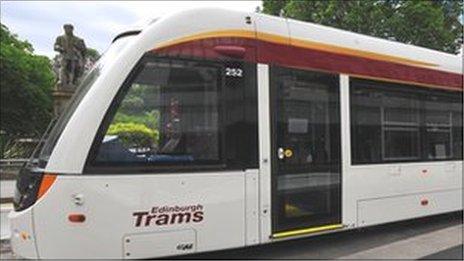Going off the rails: The Edinburgh trams saga
- Published
BBC Scotland's David Miller looks at the financial and political melodrama of Edinburgh's new tram service
Trams will return to Edinburgh's streets for the first time in almost 50 years, when the service begins on Saturday. However, in the decade since the first money was allocated to the project, the price has doubled, the network has halved and it has taken twice as long to build as was first thought.
Edinburgh's tram "network" is now just part of one of the original lines, stretching from the airport to the city centre. It had been intended to reach the waterfront at Leith and Newhaven, and there were to be other lines too, but they fell away as the troubled project rumbled on.
The idea of bringing back trams to Edinburgh's congested streets goes back many years but the current saga can be said to have begun in September 2003.
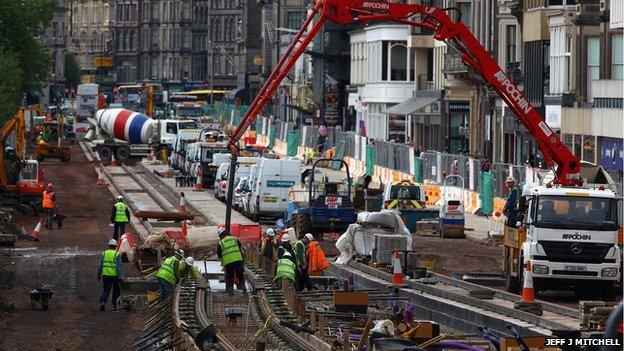
Back then the Labour-led Scottish Executive earmarked £375m, indexed for inflation, for the proposed tram routes linking the city centre with both Leith and Edinburgh Airport. It was hoped trams would be operational by 2009.
Now, more than five years behind schedule, Edinburgh has trams on its streets for the first time since 1956 but just one route, not the network that was envisaged.
The 8.7mile (14km) route stretches from Edinburgh airport to York Place in the city centre, with 15 stops along the way.
It has cost of £776m, plus more than £200m in interest on a 30-year loan taken out by the council to cover the funding shortfall.
It is something of a miracle it ever got finished at all, given the disputes along the way.
The entire project was going to be scrapped by the SNP when the Nationalists formed their first minority government at Holyrood in 2007, only for the decision to be overturned by the will of the other parties in the Scottish Parliament.
Speeded-up footage shows Edinburgh's new tram journey from the city airport to York Place in the city centre
And four years ago a bitter dispute between the arms-length company responsible for bringing trams to Edinburgh and its main contractor brought the whole project to a halt for months.
When David Mackay quit as chairman of Transport Edinburgh Limited he branded the project "hell on wheels".
Mr Mackay described the main contractor on the tram works, Bilfinger Berger, as a "delinquent company that smelled a victim".
During the darkest days of the dispute, the German construction giant said nothing publicly due to contractual restrictions.
Debbie Cannon's voice will be heard on every journey as reads out the stops and other information.
But there is little doubt that Bilfinger Berger's executives were similarly left frustrated and angry by TIE's handling of the project.
Add to all this the fact that vital roads in Edinburgh city centre and Leith were dug up for the best part of seven years, causing congestion, inconvenience and financial harm to businesses and it is little wonder that the dream of a tram system to rival any in Europe is now such a painful idea for the people of Scotland's capital.
As Edinburgh's elegant streets were transformed into a giant building site, initial scepticism was replaced by downright opposition.

It is often said by locals that Edinburgh has one of Britain's best bus services but the city council developed a new transport plan at the start of the millennium and trams were a priority.
At first the tram project was dependent on the revenues from a road-charging scheme that the City of Edinburgh Council wanted to implement, similar to that introduced in London in 2003.
But when the controversial road tolls were rejected after a public outcry, the tram scheme sailed on, backed by cash from the Scottish government of the time.
By September 2005, as the parliamentary bills for the line made their way through Holyrood the cost was put at £539m.
The new estimates of cost prove too much for the council which shelved the Granton-Newhaven and Edinburgh airport-Newbridge sections.
In March 2006 the legislation was passed in parliament, with completion now put back to 2011 and the first work to divert utility pipes and cables in Leith began in March 2007.
But work stopped as the Scottish Parliament elections arrived and in May 2007, the new SNP administration at Holyrood tried to press ahead with its pledge to scrap the trams project.
However, opposition parties outvoted the minority government and it was forced to hand-over almost £500m for the project.
The Scottish government's finance secretary John Swinney said he would give the project the cash already agreed and "not a penny more". Any further cash would have to be found by the City of Edinburgh Council.
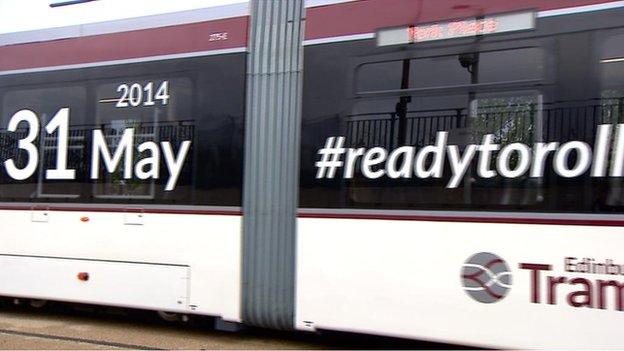
Construction could now begin and a whole new range of problems arrived.
The city centre was left gridlocked when work began on Princes Street at The Mound due to a "catastrophic failure" of traffic management and similar stories bubbled up wherever the tram works went.
Princes Street, the main route through the centre of Scotland's capital, remained closed to traffic for most of 2009, an annus horribilis for the project.
A dispute between Tie, which was overseeing the project, and the construction consortium spiralled out of control and a legal dispute dragged on for many months, putting back the finish of the project and driving up costs.
In October 2010 council officials admitted the tram line would only run to St Andrew Square in the city centre, the plan to continue to Leith and Newhaven bit the dust.
Next the chairman of the Edinburgh tram company resigned and work ground to a complete standstill.

2011 saw some sort of resolution with the contractor but a fresh crisis emerged as the council realised it did not have the money to complete the project.
Edinburgh's city council came up with a plan to stop the line at Haymarket, more than a mile west of the city centre, a decision which was labelled as "bonkers" by the city's Chambers of Commerce.
The Scottish government had to wade in again and refused to provide the final £72m of its funding if the line did not go to the city centre, forcing the council into a u-turn.
In contrast to the troubled history of the project its final two years have been relatively smooth, although by this stage it was hard to imagine what else could go wrong.
Construction of the line was finished at the end of last year and testing of the trams has been going on for several months.
Now Edinburgh is ready to get on-board its trams for the first time.
But the people of Edinburgh may take some time to love them.
- Published30 May 2014
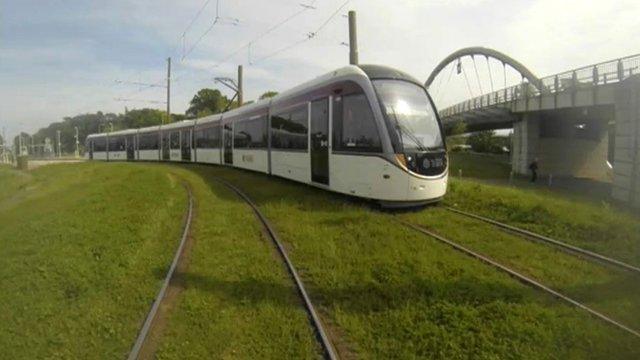
- Published2 May 2014

- Published15 September 2011
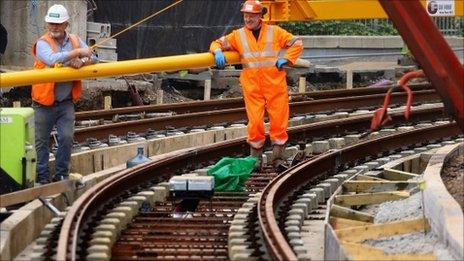
- Published2 September 2011

- Published3 November 2010
- Published26 August 2011
